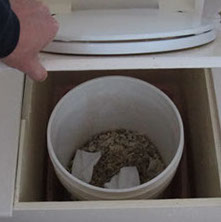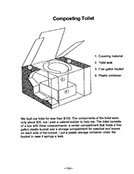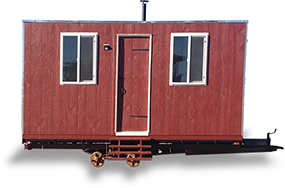Strive to change waste into a resource.


For fifteen years we have used a sawdust composting toilet. During all of that time many of our visitors have questioned our sanity. One of my friends told me he'd visit more often if he didn't have to use the bathroom like a gerbil! Marilou calls the sawdust toilet a cat box for humans. People make jokes about our toilet system because it is different and it makes them culturally uncomfortable.
It is important for you to know that the sawdust toilet does not smell. Never, in fifteen years, has any guest complained about odor. We have a vent fan next to the toilet that is turned on when the toilet is being used. We let it run for a few minutes to ventilate the bathroom. The sawdust neutralizes odors.



1. Black Waste - feces and urine
Disposal method - a sawdust composting toilet
2. Black Water - water contaminated with feces and/or urine
Disposal methods - drywell or surface mound
3. Gray Water - water that has been used but not contaminated with feces or urine
Disposal method: a drywell or surface mound or used for watering plants and trees.
4. Trash - paper, metal, plastic, etc.
Disposal method: whatever is practical and socially acceptable
A. Burning*
B. Burial
C. Sanitary landfill
D. Recycling
* While burning, use the heat for hot water or heating living spaces. Let nothing go to waste.
Resources
The sawdust toilet is one of the most important features in the ABUNDACULTURE scheme. Here are the reasons it is important:
1. When used properly with a compost pile, the sawdust toilet is sanitary. Composting is God's way of turning organic waste into an essential soil builder, replenishing nutrients that have become depleted. Without the composting process we would be buried by organic waste. If you would like to understand the science of composting, see The Composting Toilet System Book by David Del Porto and Carol Steinfeld.
2. The sawdust toilet is inexpensive and easy to build. The poorest of the poor can usually afford a five gallon bucket and a box to put it in. That's all that is needed for a sawdust toilet. There is nothing to break or drip or leak. Maintenance is very simple. I paint our wooden box with enamel paint every few years. We've used the same buckets for fifteen years.
3. The sawdust toilet saves water every time that it is used. Clean water is so precious that it seems foolish to foul it with human waste.
4. The sawdust toilet allows us to rebuild the poor soil on our homestead. Without the compost from our sawdust toilet our garden yields would not justify the work of gardening. We plant in 100% compost. Yes, you can safely use human waste as a soil amendment if it is properly composted. It's simple. The key factor is TIME. We never use any compost that has not had at least one year to cure.
Laugh if you must, but understand that the sawdust toilet can help solve serious problems that are faced by people all over the world. It is sanitary, inexpensive to build and maintain, it saves water, and it helps to regenerate worn-out soil...AND, it doesn't stink!
NOTE: If sawdust isn't available, other covering materials, such as rice hulls, shredded leaves, newspaper confetti, etc. can be used.

SAWDUST
TOILET pdf

Friends in Kenya told me about the Arbor Loo. I love the idea for its simplicity and ease of use. It is a great companion to an indoor sawdust toilet. If you live far enough in the country so that it will not create problems for your neighbors, the Arbor Loo is worth considering.
NOTES:
1. Place the Arbor Loo in an area that will not flooded, at least 15 meters from any water source.
2. Dig a hole 1 meter x 1 meter x 1 meter.
3. Build a shelter (the arbor) from available materials The base must be water and insect proof, i.e., concrete or treated lumber.
4. The shelter (arbor) is pulled over a new hole waiting for use.
5. When one hole is filled, simply move the shelter to the next hole. Immediately plant a tree in the compost of the old hole, or cover the waste with dirt. Keep animals and children away from the old hole.
6. If you use ashes or sawdust or some other high-carbon covering (see COMPOSTING), there will be minimal odors.
7. If there is a sawdust toilet inside the home, it can be dumped directly into the Arbor Loo hole.
8. The hole must always be covered—with the shelter, with dirt, or with another type of cover.
You can find excellent examples and illustrations of The Arbor Loo on the internet.






